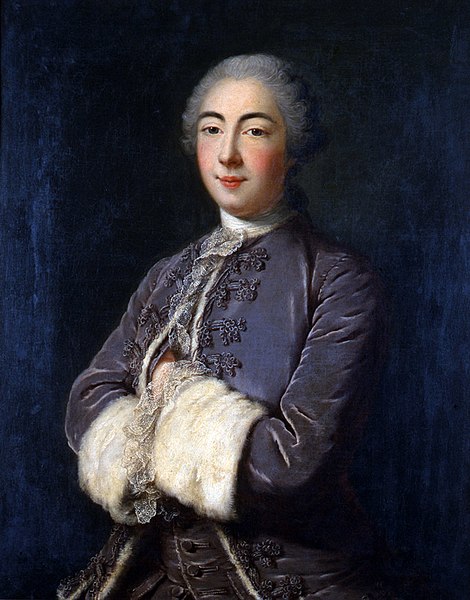Béatrix de Choiseul-Stainville was - by all accounts - a difficult woman. She was the sister of the Duc de Choiseul but could not create a life for herself at court when he became Secretary of State for Foreign Affairs in 1758. The reason was that she was unmarried - this being the case despite her having reached her 30th year in an age when noble women were married much earlier. Yet, she was determined the set up a place for herself at court and consequently requested her brother to find a husband for her.
That might have been easier if Béatrix did not have a somewhat murky reputation. She had previously very openly courted the post of Louis XV's maitresse-en-titre but had been unsuccessful. Her rejection was already the knowledge of the entire court but she did not seem to have been deterred from future attempts. While she was admittedly both intelligent and capable, she was also incredibly dominating, ambitious and somewhat shameless in her pursuits of her goals. For instance, her attempts at winning the king's affection had been entirely destroyed by her brazenness - the skittish king was thrown completely off by her open attempts at seducing him.
 |
| Béatrix de Choiseul-Stainville |
Thus, her problem in 1758-59 was that she could not live permanently nor participate in court activities without having been officially presented - and for that to happen, she had to be married.
This is where her brother stepped in. Even with her faults, she was still the sister of a powerful minister who - at the time - had the king's ear. Yet it seemed to have been difficult for the Duc de Choiseul to find a man of suitable rank willing to marry his sister. Finally, he reached an agreement with Antoine VII, Duc de Gramont.
The Duc de Gramont was not much older than Béatrix, just 7 years. There appears to have been an understanding between the two ducal families that the marriage was merely pro forma. As such, Béatrix could claim her position at court both as a married lady and as a duchess. Consequently the union was celebrated on 16 August 1759. If anyone had any doubts that the marriage was little more than a gateway for Béatrix to the gilded halls of Versailles, they were quickly removed when the couple separated - just three months after the wedding. Yet, this separation was not legally binding until an official application for separation had been granted by the Châtelet du Paris.
Apparently, this application for a separation had been filed by Béatrix and was finally granted on 18 July 1761. So while the couple had not lived together for almost three years, they had still been - legally - considered to be husband and wife.
It is unknown what caused the Duc de Gramont to agree to such a union. The couple had no children; indeed, she would immediately move to her brother's household which she quickly took over. As for Antoine, he already had a legitimate heir to his title. He had been married once before to Marie Louise Victoire de Gramont (his first-cousin) who had given him a son before dying in 1756.
 |
| Antoine VII de Gramont |
In "Marie Antoinette, Her Early Years" the author briefly mention the rapid breakdown of the couple's marriage but also give a clue as to the Duc de Gramont's reasons to accept. It was suggested that Antoine "preferred the company of the members of the corps de ballet". While that may be more gossip than fact, it would not be unthinkable that the Duc was more inclined to accept a wife if it would lead attention away from his affairs - especially if the affairs were with other men. Of course, this is entirely speculation but that would allow him to continue his affairs while enjoying the respectability of a conventional marriage in an age where homosexuality was not just illegal but punishable by death. To Béatrix, it would also be an ideal arrangement.
She would not have to endure having to submit to her husband's will while still being able to take his rank at court. She, too, would avoid the stigma of being an unmarried, non-ecclesiastical woman and she would be able to stand by her brother as his career advanced at court.
Their marriage was to endure - albeit in name only - for a staggering 34 years until the revolution. During this time the couple can hardly be said to have resembled anything other than mere acquaintances. Surprisingly, the whole affair does not appear to have made much of a stir at court. While it should be remembered that all marriages within the aristocracy were arranged marriages of convenience, it was still a rare thing to have the matter dealt with so bluntly. Otherwise it would not be uncommon for husband and wife to live in what amounts to little more than a partnership focused on furthering the interests of their family.

No comments:
Post a Comment